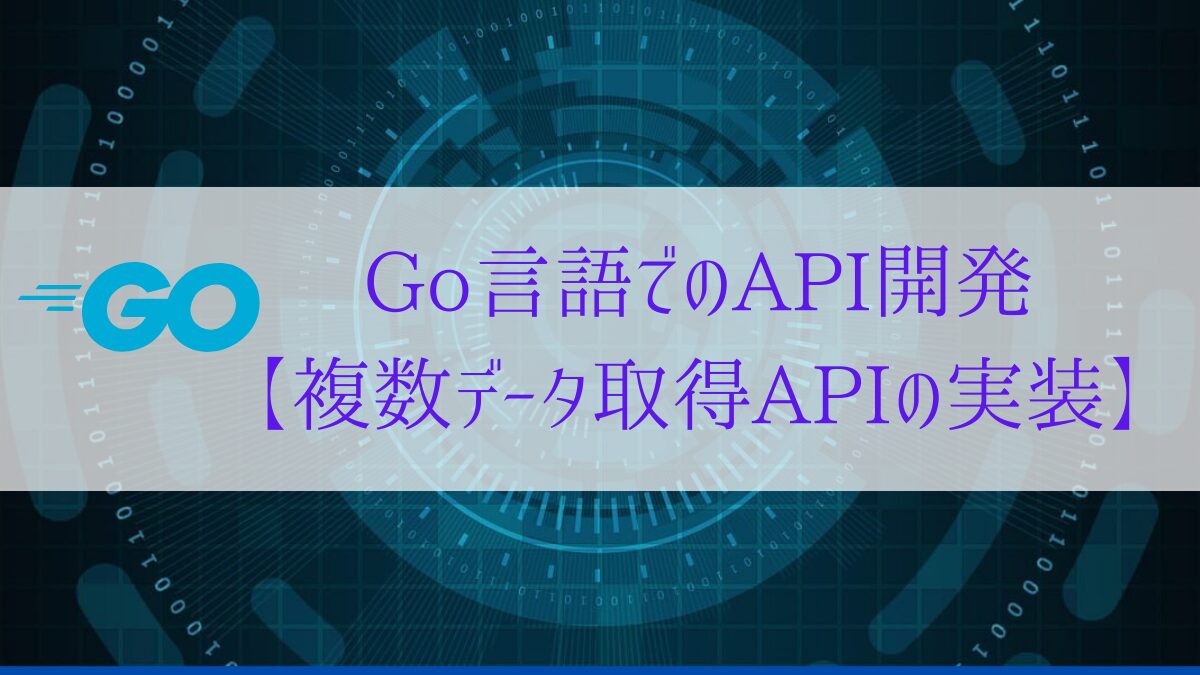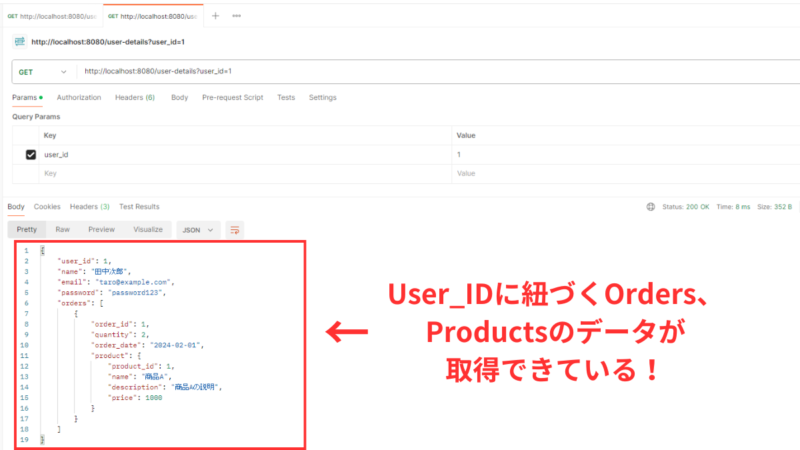【複数データ取得APIの実装】Go言語でのAPI開発 | 実践的な学習から実装まで⑤

たけのこ
こんにちは!たけのこです。
今回も引き続き、Go言語を使用したAPIの実装方法について解説していきます。
前回は、データ更新APIの実装について解説してきました。
今回は、その記事の続きで複数テーブルを結合して、指定したIDに紐づくデータを取得するAPIの実装について解説していきます。
実際の現場でも実装することが多いので、覚えておいて損はないと思います!
では、早速行きましょう!
目次
スポンサーリンク
Step 1:domain層の実装
事前に「Users」「Orders」「Products」の3テーブルを用意していたと思いますが、各テーブルに対応する構造体を作成していきます。
(Userテーブルは過去に実装しているので、省略します。)
package domain
type Order struct {
OrderID int `json:"order_id"`
Quantity int `json:"quantity"`
OrderDate string `json:"order_date"`
Product Product `json:"product"`
}package domain
type Product struct {
ProductID int `json:"product_id"`
Name string `json:"name"`
Description string `json:"description"`
Price float64 `json:"price"`
}Step 2:repository層の実装
指定したuser_idに基づいて3つのテーブルを結合し、データを取得するクエリを実行するリポジトリを作成します。
package repository
import (
"database/sql"
"myApiProject/internal/domain"
// ↓の1行をimportに追加
"strconv"
"strings"
)
/*
* ~ 前回までのUpdateUserロジック ~
*/
// ここから下のコードを新たに追記
func (repo *UserRepository) GetUserDetails(userID string) (*domain.User, error) {
// クエリ準備
query := `
SELECT u.user_id, u.name, u.email, u.password,
o.order_id, o.quantity, o.order_date,
p.product_id, p.name, p.description, p.price
FROM Users u
LEFT JOIN Orders o ON u.user_id = o.user_id
LEFT JOIN Products p ON o.product_id = p.product_id
WHERE u.user_id = ?`
// クエリ実行
rows, err := repo.db.Query(query, userID)
if err != nil {
return nil, err
}
defer rows.Close()
var user domain.User
var orders []domain.Order
// 取得結果を準備
for rows.Next() {
var order domain.Order
var product domain.Product
// 取得結果を各構造体に格納
if err := rows.Scan(&user.UserID, &user.Name, &user.Email, &user.Password,
&order.OrderID, &order.Quantity, &order.OrderDate,
&product.ProductID, &product.Name, &product.Description, &product.Price); err != nil {
return nil, err
}
order.Product = product
orders = append(orders, order)
}
user.Orders = orders
return &user, nil
}ちょっと複雑なので、ザックリ解説すると、
- 実行するSELECTクエリを発行し、query変数に格納。
- クエリを実行し、rows変数に結果を格納。
- 取得したデータをfor文で1行ずつ読み取り、各構造体に格納。
- 各構造体に格納していたデータを
「User←Order←Products」の形になるように格納。
というような処理を行なっています。
Step 3:usecase層の実装
ここは、前回とほぼ同じとような実装になります。
package usecase
import (
"myApiProject/internal/domain"
"myApiProject/internal/repository"
)
/*
* ~ 前回までのUpdateUserロジック ~
*/
// ここから下のコードを新たに追記
func (uc *UserUseCase) GetUserDetails(userID string) (*domain.User, error) {
return uc.repo.GetUserDetails(userID)
}
Step 4:handler層の実装
こちらの実装もGetUserメソッドと、ほぼ同じです~
package handler
import (
"encoding/json"
"myApiProject/internal/domain"
"myApiProject/internal/usecase"
"net/http"
)
type UserHandler struct {
useCase *usecase.UserUseCase
}
/*
* ~ 前回までのUpdateUserロジック ~
*/
// ここから下のコードを新たに追記
func (h *UserHandler) GetUserDetails(w http.ResponseWriter, r *http.Request) {
userID := r.URL.Query().Get("user_id")
if userID == "" {
http.Error(w, "User ID is missing", http.StatusBadRequest)
return
}
userDetails, err := h.useCase.GetUserDetails(userID)
if err != nil {
http.Error(w, "Internal server error", http.StatusInternalServerError)
return
}
w.Header().Set("Content-Type", "application/json")
json.NewEncoder(w).Encode(userDetails)
}Step 5:ルート設定
あとはいつも通り、URLを設定します。
package router
import (
"database/sql"
"myApiProject/internal/handler"
"myApiProject/internal/repository"
"myApiProject/internal/usecase"
"net/http"
)
func NewRouter(db *sql.DB) *http.ServeMux {
repo := repository.NewUserRepository(db)
useCase := usecase.NewUserUseCase(*repo)
userHandler := handler.NewUserHandler(useCase)
router := http.NewServeMux()
router.HandleFunc("/user", userHandler.GetUser)
router.HandleFunc("/user-update", userHandler.UpdateUser)
//↓の1行を追加
router.HandleFunc("/user-details", userHandler.GetUserDetails)
return router
}実装したAPIの実行!
では、最後に実装したAPIをPostmanから呼び出してみましょう!

さいごに
今回は複数のデータを結合して取得するAPIの実装方法について解説しました。
クエリ自体はJOIN句でテーブル同士を結合するだけなので、そこまで難しくはありませんが、データ構造がちょこっとだけ変わるので、そこだけ注意ですかね~
というわけで、今回はこの辺りで!ありがとうございました!
スポンサーリンク
ABOUT ME

